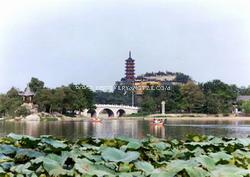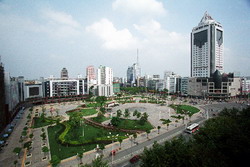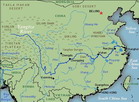2020 Yangtze River Cruise and Ferry Starting from 79 USD p.p.!
ZHENGJIANG Introduction
Zhenjiang, on the south bank, is
situated in the middle of Jiangsu Province,
at the junction of the Yangtze and the Grand
Canal, 63 kilometres (40 miles) from Nanjing.It
was the capital of  the province during the Republican
period (1911--49) when Nanjing was the national
capital. Earlier Chinese travellers classified
Zhenjiang's scenery as 'The Best Landscape under
Heaven', and indeed the area known as the Southern
Suburbs was often used as a theme in landscapes
by famous Chinese painters-Marco Polo may have
visited the city in the 13th century, commenting:"The
people of Zhenjiang live by industry and commerce,
they produce much silk and brocade and the rustic
flavour of the place is suitable for the production
of many things."
the province during the Republican
period (1911--49) when Nanjing was the national
capital. Earlier Chinese travellers classified
Zhenjiang's scenery as 'The Best Landscape under
Heaven', and indeed the area known as the Southern
Suburbs was often used as a theme in landscapes
by famous Chinese painters-Marco Polo may have
visited the city in the 13th century, commenting:"The
people of Zhenjiang live by industry and commerce,
they produce much silk and brocade and the rustic
flavour of the place is suitable for the production
of many things."
The American Nobel Prize-winning
writer, Pearl S Buck (1892--1973), author of
The Good Earth and other novels about China,
lived in Zhenjiang for 15 years before attending
boarding school in Shanghai. Her missionary
parents'house still stands in the northern part
of the city, incorporated into a radio factory.
Handicrafts include jade carvings, palace lanterns
and screens of natural stone. Zhenjiang is also
known for its black vinegar and pickled vegetables.
HISTORY OF ZHENJIANG
Zhenjiang, under various names,
has existed for 2,500 years. In 213 BC, its
importance as a  ferry crossing led Emperor Qin
Shihuangdi to conclude that Zhenjiang’sjengshui
(geomantic) powers were too strong. He ordered
3,000 prisoners to dig a tunnel through one
of the hills to divert the influences.
ferry crossing led Emperor Qin
Shihuangdi to conclude that Zhenjiang’sjengshui
(geomantic) powers were too strong. He ordered
3,000 prisoners to dig a tunnel through one
of the hills to divert the influences.
During the convoluted politics of
the Three Kingdoms period (220--265), Sun Quan,
ruler of the kingdom of Wu, made his capital
here and Zhenjiang was the site of many 'mini-summits'
on military strategy between the warring kingdoms.Thereafter
the settlement grew steadily, benefiting greatly
from the construction of the Grand Canal under
the Sui dynasty (581--618). Its key location
at the intersection of the Grand Canal and the
Yangtze made it the hub of water transportation
from the seventh century onwards.
Under the Song dynasty (960--1279)
the city's development reached its height,producing
fine silks, satins and silverware as tribute
to the imperial court. Troops were stationed
here to defend the river (Zhenjiang means 'guard
the river')--a wise precaution, as it turned
out, when they had to take on invading in troops
in a naval battle near Jin Shan in 1130.
During the Opium War of 1842, Zhenjiang
was bombarded by British men--of war. Seven
thousand British troops stormed the walled city,
which was defended by only about 3,000 courageous
Chinese soldiers. The governor of the city and
his family committed suicide. On the British
side, 105 soldiers were killed or wounded.This
battle was a turning point, as it led to the
signing of the Treaty of Nanking only a month
later. The treaty provided for the surrender
of Hong Kong to Britain and for the payment
of 21 million Mexican dollars by the Chinese
as indemnity.
indemnity.
The city was again captured in 1853
by the Taiping rebels and held by them for four
years, which left it crippled for some time.
A small foreign concession area was established
in 1861. A H Rasmussen, a Scandinavian trader
who lived in Zhenjiang for many years, wrote:
Then I went into the silent
street for a breath of fresh air and walked
up and down the bund, three hundred paces one
way and three hundred paces back. To get a little
change l walked up and down the only cross street
to the south gate of the Concession, two hundred
paces one way and two hundred paces back.
Life was very restricted, and the
hunting of wild boar in the surrounding hills
became the main pastime for the resident foreigners.
Trade recovered, however. Customs
house records show that in the first decade
of the 20th century the value of goods trans-shipped
in one year through Zhenjiang exceeded a staggering
35 million taels of silver (one tael is roughly
50 grammes or 1.8 ounces).
But the coming of the railway put
an end to this spate of merchandise; by the
1920s, much of it was being conveyed by freight
trains. Yet Zhenjiang is still a busy transportation
hub. A new port at nearby Dagang has enhanced
its importance and it is on the Shanghai-Nanjing
railroad line. industries include metallurgy,
electronics and vehicle and ship construction.
• ZhengJiang
• What
to See in ZhengJiang (1)
• What
to See in ZhengJiang (2)
• The Grand
Canal



